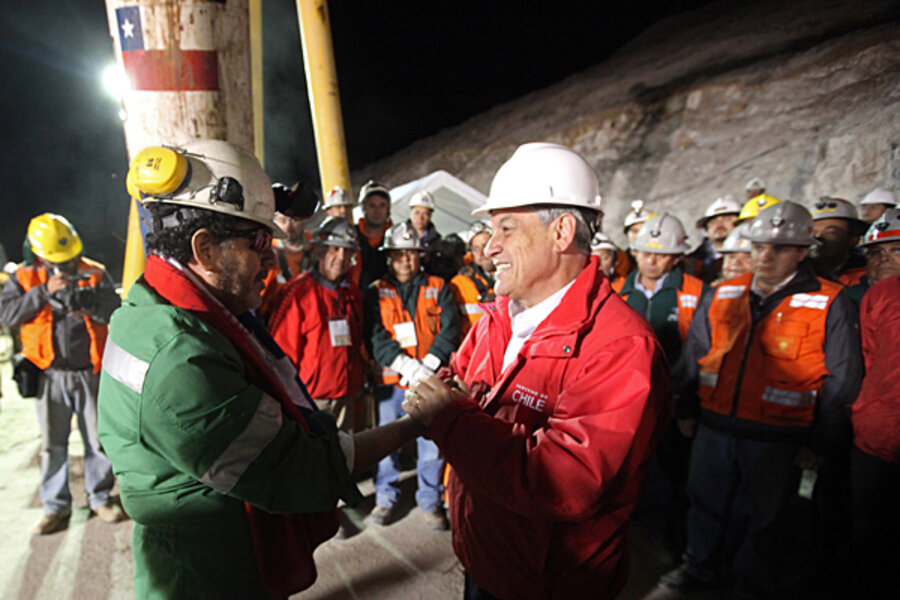Chile mine rescue may spur more rescue efforts worldwide
Loading...
| Santiago, Chile
Chile's 33 trapped miners hadn't even been hauled to the surface when a coal mine collapse in Colombia trapped two more workers. Days later, four more miners were trapped underground in Ecuador. And in China, a coal mine explosion Saturday trapped 16 underground.
In each case, rescuers scrambled to save lives. In Colombia, authorities kept digging for four days before finding the miners' bodies. In Ecuador, efforts continued today to rescue two miners trapped underground since Friday, with President Rafael Correa personally getting involved. In China, hundreds of rescue workers searched until today following the accident Saturday.
Industry insiders say the intense efforts to rescue these trapped miners, rather than writing them off for dead, may be one of the lasting impacts of the San Jose mine rescue. The Chilean miners survived a half-mile underground for 17 days before making contact with rescue workers, persevering for a total 70 days before returning to the earth's surface.
RELATED: 5 reasons the Chile mine rescue was so successful
Worldwide exposure of that rescue mission will make it more likely that authorities will mount future rescue efforts, says Richard Soppe of Center Rock Inc. in Pennsylvania, which manufactured the massive drill bits used to rescue the miners in Chile. "This was deepest rescue ever imagined, much less completed, and that they made it 17 days with nothing, no contact or support from outside at all, will make rescues more likely."
Mr. Soppe says he hopes that mining areas, whether at the state, national, or international level, start to prepare for disasters so that rescue responses can be faster. Preparation ahead of the Chile accident could have cut two weeks off of the rescue time, he says.
Pressure for reform
Mine safety and rescue efforts have improved in recent years. Even before the San Jose mine situation, Center Rock was in touch with South African authorities about selling them large-diameter drilling equipment to facilitate rescues of trapped miners, says Soppe. A Chinese rescue company was also shopping for rescue equipment as recently as last week, he adds.
But the unprecedented San Jose rescue is now putting pressure on governments worldwide to do more. Keith Slack, the senior policy adviser and campaign manager for extractive industries at Oxfam America, told the Monitor last week that many nations sense the need "to strengthen government capacity to deal with mine-related problems. This Chile situation helps emphasize that even more.”
The accident spurred the Chilean government to assemble a new panel of experts to improve safety in all industries. "We want a before and an after in terms of safety and dignity," said Chilean President Sebastian Piñera.
The Chile rescue is also raising new doubts about government responses to past mine disasters. In Mexico, the bishop of Saltillo has called for new prosecutions related to the deaths of 65 workers in the Pasta de Conchos coal mine in 2006. In that disaster, the mine owners halted rescue efforts after four days, raising complaints from some rescuers and family members, Mexico City newspaper La Jornada reported. The Chile rescue showed that the rescue was halted too early, the bishop said.
Doubts over lasting change
Not everyone is impressed with Chile's new safety efforts. Lautaro Carmona, a legislator with the opposition Communist party who represents the mining city of Copiapo, which includes the San Jose mine, says Mr. Piñera excluded workers' representatives from the new mine safety panel and has so far failed to respond to ideas offered by unions.
While mine rescue may become more common in some parts of the world, the United States is unlikely to change, as rescue attempts already meet strong standards, says Bob Ferriter, senior safety specialist at the Mine Safety and Health Program at Colorado School of Mines.
"It won't change practice in the USA. Here, the rescue team goes in as soon as they are safe, and try to find victims," Mr. Ferriter said today in a phone interview. "Since the Sago mine disaster in 2006, you need a refuge within 1,000 feet of the working face. So you know more or less where they are."





